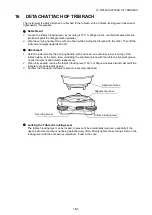
15-1
15 USING USB FLASH DRIVE
15
USING USB FLASH DRIVE
It is possible to read in/output data from/to a USB flash drive.
•
When using a USB flash drive, data is stored in the root directory. You cannot read/write data from/
to subdirectories.
•
When using the ES, an MS-DOS-compatible text file can be input/output.
•
You can neither save a file under the same name as a read-only file, nor change/delete the name of
a read-only file. (However, this varies depending on the model or software you are using.)
•
For "Communication Manual" that describes details on the communication formats used for
inputting/outputting data to/from a USB flash drive, please consult with your local dealer.
•
When using the ES, you can use a USB flash drive with the capacity of up to 8GB.
15.1 Inserting the USB flash drive
•
Do not remove the USB flash drive during data read/write. Doing so will cause data stored in the
USB flash drive or the ES to be lost.
•
Do not remove the battery or turn off the power during data read/write. Doing so will cause data
stored in the USB flash drive or the ES to be lost.
•
Waterproofing property for this instrument is not secured unless the battery cover and external
interface hatch are closed, and the connector caps are correctly attached. Do not use it with these
open or loose, under the condition where water or other liquid spills over the instrument.
PROCEDURE
1
Slide the catch on the external interface hatch cover
down to open.
2
Insert the USB flash drive in the respective slot.
•
When using a USB memory with 4 metal terminals on
the surface, insert it with the terminal facing backwards
to avoid damaging the USB port.
3
Close the cover.
Listen for the click to ensure that the cover is properly
closed.
External
interface
hatch






























